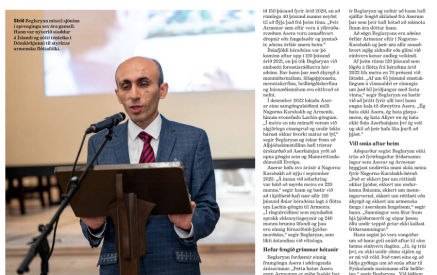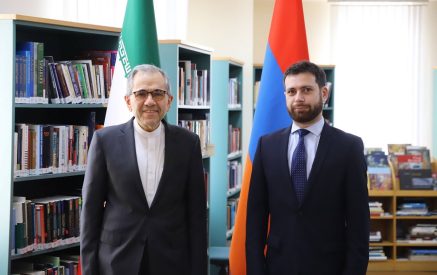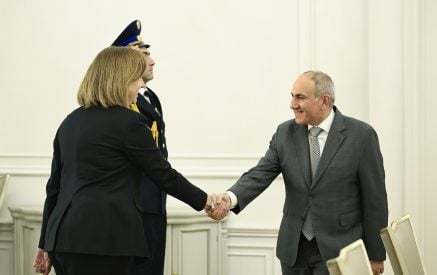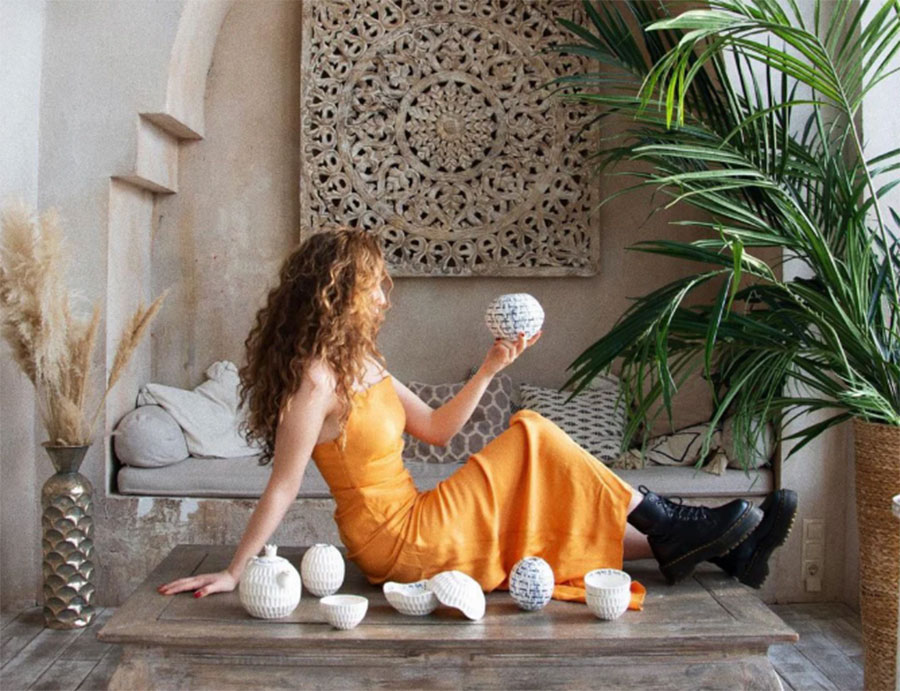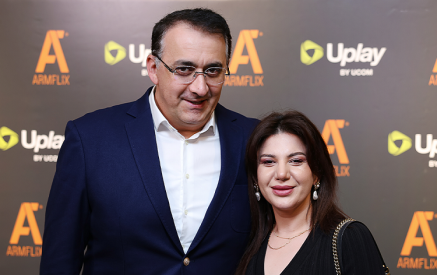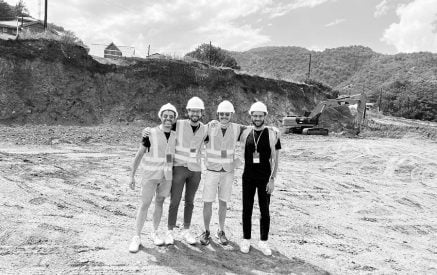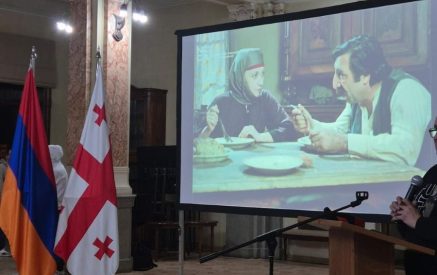by Milena Baghdasaryan
“Crafting Armenian Spirit into Every Piece. Our handcrafted ceramics embody the essence of Armenia, featuring motifs inspired by Armenian poets, elegantly intertwined with minimalist designs. Each creation is a harmonious blend of tradition and modernity,” reads the homepage of Brutents Ceramics. Despite her young age, 28-year-old Mane Brutents has successfully established a brand of handmade ceramic collections that have captured hearts worldwide. Her unique and creative art pieces bring a new style and voice to the world of Armenian ceramics, combining elements from an array of art forms and creating tiny figures that are pleasing to the eye and touching for the soul. In this inspiring interview, we discuss her art and brand, exploring the intricacies of working with ceramics and her journey in the business world.
Mane Harutyunyan (Brutents) (M.H.): “Brutents” is my ancestors’ surname. They were ceramicists in the city of Goris (Syunik, Armenia) for centuries. “Brut” in Armenian means potter, and the surname “Brut + ents” was likely formed to highlight their connection to their craft.
M.B.: What inspired you to start working with ceramics? Do you remember your first attempt? What was the first art piece you created?
M.H.: I started doing ceramics in university while studying interior design in 2012-2016. We had many minor courses in sculpture and working with clay. While writing my thesis, I became so fascinated with pottery that I asked a barely familiar pottery master who had a ceramics studio to take me as an apprentice to work for free in exchange for his knowledge and experience. My first piece was a huge lamp in the shape of a cat. I worked there for a couple of months and then decided to apply to the ceramics faculty at the Stroganov Academy of Art in Moscow.
M.B.: Can you walk us through your creative process, from ideation to a finished piece?
M.H.: There are several techniques for working with clay: you can make a cup on a pottery wheel, or by hand, which is called hand-building, and there’s also the technique of working with liquid clay. I work in all three techniques. Regardless of the technique, the stages are almost the same. After shaping, the piece needs to dry for several days. Then it must be fired in a kiln at 1,000 degrees. That process takes about 24 hours. This turns the fragile clay into a harder material, ready for glazing. After the first firing, I decorate it with rhymes and glaze it, and then it goes back to the kiln for a final firing. The temperature of the second firing is much higher than the first, 1,200-1,250 degrees, and it also lasts about 24 hours. After the second firing, the piece is ready for use. The clay has become a ceramic.
M.B.: Are there any themes, symbols or motifs that consistently appear in your ceramic artwork? How do you choose which symbols to feature in your work? Is the choice based simply on aesthetics, or does it also have a symbolic significance?
M.H.: I really love Armenian poetry and try to combine it with simple, minimalist shapes, thus infusing these pieces with soul and meaning. I particularly enjoy decorating my work with poems by my favorite Armenian poets: Sahyan, Tumanyan, Charents, Teryan, Isahakyan, Sevak…I usually paint according to my mood. Sometimes the theme is more romantic, while other times it is more philosophical.
M.B.: Where do you find inspiration? Does the idea of the final shape and design come to you before you start working with the material or during the work process itself?
M.H.: I believe that the word “inspiration” often relates to something you don’t like, where you need to find inspiration to force yourself to do it. For the most part, I feel like I live within my craft, and it is one big source of inspiration for me. Sometimes, I have so much inspiration that I don’t even know how to handle it all or keep up with bringing my ideas to life. In cases when I need to come up with a new collection, I visit museums, mainly the British Museum now, so that my eyes can see and saturate with beauty and generate new ideas.
M.B.: Do you follow traditional Armenian ceramic-making techniques, or have you come up with your own unique work style and method?
M.H.: I think I inherited from our ancestors a love for combining blue and white in ceramics and for painting ornaments, which sometimes include Armenian words. This style was characteristic of the masters from the city of Kütahya in Turkey, where there were many Armenian craftsmen. Their works predominantly featured the combination of white and blue until the 17th century. In my work, I blend modern forms and styles of tableware with the traditional Armenian white and blue combination, integrating my love for ceramics.
M.B.: You and your art have traveled a lot. How have those trips and encounters with other cultures and traditions influenced your work?
M.H.: The most wonderful thing about international exhibitions and markets is that people from other cultures get to know Armenian culture in a more contemporary form. Many people are already familiar with our culture, while others are encountering it for the first time, and I am delighted to be the bridge for this initial introduction. My time in London has a significant impact on me. The studio where I am currently a resident is full of talented ceramicists. They find my work fascinating, and I feel the same about theirs. We inspire each other daily and learn new techniques, despite our different styles. Healthy competition is a wonderful motivator for artists.
M.B.: Despite all the journeys abroad, your art is still very much focused on and influenced by Armenian culture. We often see you incorporate elements of Armenianness (e.g. alphabet, poetry, song lyrics) into your ceramic pieces. What is the reason or the story behind such a strong dedication to your origins?
M.H.: I used to be troubled by the fact that I couldn’t move away from my Armenian identity as an artist. I have many ideas with more neutral themes, but I always feel drawn back to Armenian motifs. I’ve come to understand that I am woven from Armenian threads, and my genetic code is very strong. Whenever I introduce myself in different countries, I always highlight the inseparable part of my Armenian heritage. My surname, Armenia and I are always mentioned together. Even when I create pieces with neutral themes, I add a very small detail at the end, something in Armenian, or I sign my name in Armenian. I can’t break this habit.
M.B.: Do you have a favorite piece you’ve created? If so, what makes it special to you?
M.H.: There’s the smallest Kroonk vase on my dining table at home. I love it dearly. It’s so tiny, only six cm tall, but it attracts so much attention. Another favorite of mine is a handleless teacup. I love holding the cup and feeling the hot tea. Not everyone finds it convenient to drink from a handleless cup, but I enjoy drinking tea from it.
M.B.: Are there any ceramicists (Armenian or non-Armenian) who have inspired your work and shaped your ceramic journey?
M.H.: Eight or nine years ago, when I was in university, I was inspired by Erik Landon, known as TORTUS. He is a master in pottery. I dreamed of studying with him and going to Copenhagen for one of his workshops. His technique is amazing. A year ago, while working on my pieces in a London studio, I accidentally saw him visiting the studio. I couldn’t believe my eyes! To say I was happy to meet my motivator would be an understatement. He praised my work, and I finally gathered the courage to ask him to collaborate with me. We ended up creating a large vase together, which I later decorated.
M.B.: I know you ship your artworks worldwide. Are the buyers mainly Armenians from the diaspora or non-Armenians who are interested in your work? If foreigners are interested in your art, what do you think attracts them to your work?
M.H.: Most of my customers are Armenians, tourists from the diaspora, and there’s also a significant percentage of foreign buyers who are married to Armenians and lovingly purchase Armenian-themed ceramics for their partners. But to my surprise, in London, almost all of my customers are local Londoners or Europeans who have no connection to Armenia, but they appreciate the uniqueness and exoticism of my ceramics.
M.B.: Currently you have a successful business, with studios in both Yerevan and London, worldwide recognition and thousands of followers on social media. Did you have the idea of turning your art into business from the very beginning, or did you come to this decision gradually?
M.H.: I’d be lying if I said I had absolutely no idea that this would become a well-known brand. When I started making cups, they were intended only for me and my friends, but there was so much support and admiration from my friends. Since there weren’t any works in this style on the Armenian market at that time, I felt like this idea would be popular. I quit my main job to become a full-time ceramicist, and intuitively, I took every step towards creating a brand. The current success is actually the result of very hard work. I changed many studios, moved my kiln from one country to another many times, because I believed in the future of the brand. Indeed, ceramics, especially for a female, involves physically demanding work. My parents often said that I would hurt my back, and I should stop doing such heavy work. But none of that mattered to me. I loved and still love the way I’ve chosen. There were no easy paths; all of this is the result of hard work.
M.B.: How do you balance the needs of art and business? Do the buyers’ preferences have a say in what Mane Brutents will create next, or does the artist still have complete freedom in deciding what she creates?
M.H.: It’s also challenging not to succumb to the desires of others and to do everything following my intuition. I trust my intuition a lot. If it led me to build a brand that people love, then I must continue to follow it. But when it comes to bureaucratic matters, my accountant helps me, and I listen to my husband regarding financial management. In everything else, I listen only to myself.
M.B.: Could you walk us through your exhibition history? Are there any upcoming projects or exhibitions we should keep an eye out for?
M.H.: I have good news — we have started making unique tableware for restaurants in Yerevan. This is a good step towards influencing people’s tastes and encouraging restaurants to order from local businesses instead of ordering from abroad. But now I really want to separate the tableware brand from my personality, because I feel like I’m thinking more about business matters than my artistic career. I really want to create large installations for galleries and exhibits in London, so for now I’m balancing and contemplating a new collection of vases.
M.B.: What advice would you give to aspiring ceramicists? What was the best advice given to you when you were just starting?
M.H.: I would advise you to find your style by trying out a variety of techniques and not to stop at copying other artists (it’s a normal stage to go through at the beginning; everyone experiences it). Instead, strive to incorporate your inner self into your work. Believe me, people are captivated by sincerity and individuality.














